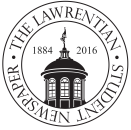Known for the YouTube video titled “I LOVE TOFU!!!” and other hits songs like “I Peed on a Bird,” Rushad Eggleston remains one of the most eccentric performers of our day. Self-described as a “joy-spreader” and “cello goblin,” Eggleston shared new techniques and performance practices with Lawrence on Sunday, Feb. 3, in a workshop followed by a concert in the Esch-Hurvis Studio at Warch.
During the workshop, Eggleston sat on stage with his cello while attendees gathered around. He began the “workshop of advanced musical knowings” by teaching students about his technique of bouncing the bow. Eggleston has perfected complex bow-bouncing sequences, enabling him to play many fast notes. He talked about chords being the key to interesting improvisation, and he emphasized the importance of experimentation in practice. The string players in attendance participated in call-and-response with enthusiasm.
Eggleston talked with attendees about his creativity, his history playing the cello and his made-up language. Beyond his growling, primal yawps and wild cello playing, Eggleston imparted heartfelt wisdom about how believing in oneself opens up infinite possibilities. While this workshop set the stage for the later concert, nothing can fully prepare one for a first-time concert experience with Rushad Eggleston.
At the concert, Fiddlers of Lawrence University (FLU) copresident senior Trace Hybertson was called upon to introduce Eggleston as “the giggler.” Eggleston made his way from the back of the room to the stage while playing his cello. He wore a bright pink tunic held together with pieces of duct tape over pink patterned tights. He spoke and sang in his own language, and he played the two kazoos strapped to the scroll of his cello—one made of metal and one of wood. Eggleston further introduced himself and his cello, called “Jesus,” and gave a brief explanation of his performance style. He said his concert would differ from a normal concert in two main ways: first, he would be “uttering much nonsense” which to him is “as delightful as music to compose;” second, his concert would include a lot more notes than usual concerts.
Eggleston fulfilled these expectations and exceeded them—no one could guess what he would do next in the performance. Interludes of talking to the audience flowed seamlessly into cello and kazoo playing, gibberish poetry, death-metal growling, singing and more. Beyond his technical proficiency, he used his ability to read an audience to influence his programming. He openly requested applause at times and precluded it with his odd behavior at others. In one segment of the show, Eggleston lulled the audience into a daze with a repetitive rhythmic pattern on his cello. After a few minutes passed in this manner, he jumped off the stage and screamed, pulling everyone right back into his program.
At regular intervals in the show, Eggleston’s antics began to seem like an overused schtick, then he would turn to the audience and say something so real and meaningful it caught everyone off guard. For example, after bemoaning the annoyances of flaky people, Eggleston turned to the audience with a hard look and said, “Everybody’s flaky about something…some people are very responsible, but they’re flaky when it comes to their dreams.” Eggleston followed a similar pattern with his music; he interspersed performances of his many compositions and improvisations with a gentle, beautiful fiddle tune in pizzicato and even performed works by J.S. Bach with expert musicality, showing his ability to oscillate from one mode of playing to the next.
Eggleston’s self-awareness and depth combined with his amazing cello chops made his concert one of the most engaging performances I have experienced in a long time. It reminded everyone of the myriad possibilities available to any musician in practice and performance. Eggleston showed that a willingness to think outside the box, while extreme in his case, can lead to exciting opportunities.

